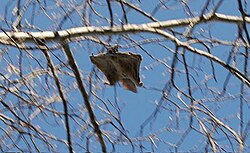This article includes a list of references, related reading, or external links, but its sources remain unclear because it lacks inline citations .(October 2021) |
| Large black flying squirrel | |
|---|---|
 | |
| Black flying squirrel, Aeromys tephromelas | |
| Scientific classification | |
| Domain: | Eukaryota |
| Kingdom: | Animalia |
| Phylum: | Chordata |
| Class: | Mammalia |
| Order: | Rodentia |
| Family: | Sciuridae |
| Subfamily: | Sciurinae |
| Tribe: | Pteromyini |
| Genus: | Aeromys Robinson & Kloss, 1915 |
| Type species | |
| Pteromys tephromelas Günther, 1873 | |
| Species | |
Large black flying squirrels[ citation needed ] (genus Aeromys) form a taxon of squirrels under the tribe Pteromyini. They are only found in South-east Asia.








